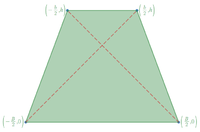Hello, could anyone help me with those two tasks?
1. The longer base of a trapezoid ABCD is AD, the diagonal is AC perpendicular to the leg CD and it is dividing the angle BAD in a half. The angle CDA = 600. The perimeter of a trapezoid is 80cm.
Find the bases of a trapezoid.
2. Equilateral trapezoidal lateral transverse lines intersect at right angles. The bases of a trapezoid are 5 and 11. Find the height of a trapezoid.
1. The longer base of a trapezoid ABCD is AD, the diagonal is AC perpendicular to the leg CD and it is dividing the angle BAD in a half. The angle CDA = 600. The perimeter of a trapezoid is 80cm.
Find the bases of a trapezoid.
2. Equilateral trapezoidal lateral transverse lines intersect at right angles. The bases of a trapezoid are 5 and 11. Find the height of a trapezoid.
Last edited by a moderator:


